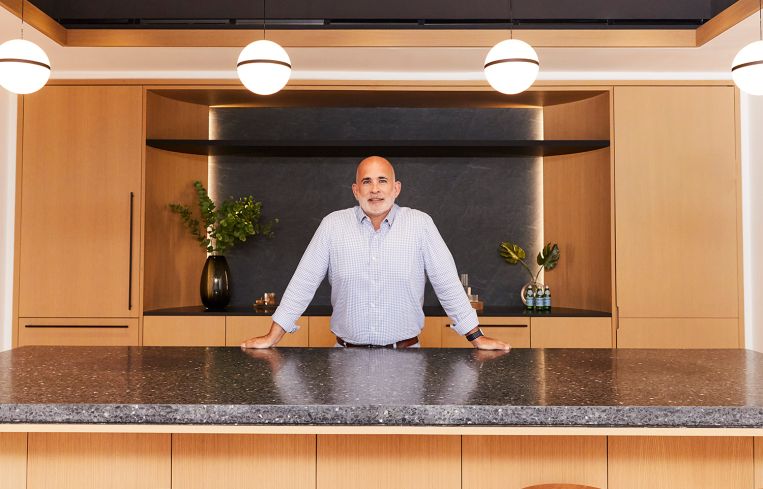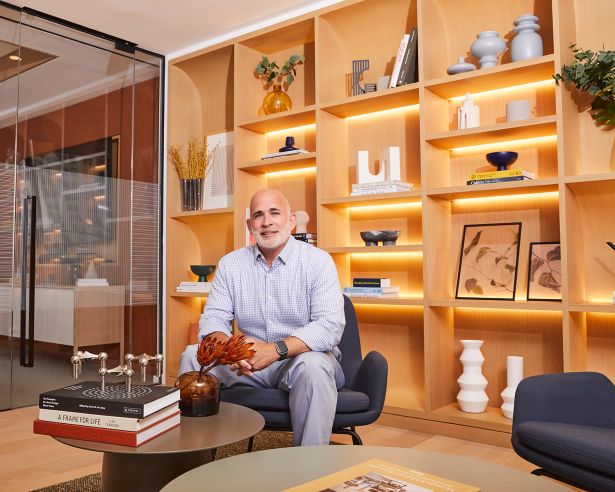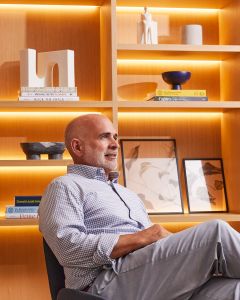BGO’s Rob Naso On the Landlord’s New Move-In-Ready Office Model
The company’s rolling out the concept in New York, Boston, Chicago and other cities to attract tenants that might be uncertain about their office needs
By David M. Levitt August 29, 2023 10:50 am
reprints
Oh, what do tenants want?
The psychoanalysis of commercial real estate tenants is going on in landlord shops coast to coast as they collectively deal with the post-pandemic reality of workers who have discovered they actually have a choice on whether to come into the office.
BGO, known until recently as BentallGreenOak, is no exception. BGO is a Miami-based, privately held global investment fund with interests in all four traditional commercial real estate food groups: office, multifamily, retail and industrial.
It has spent the better part of a year creating a model at its offices at Manhattan’s 685 Third Avenue, near Grand Central Terminal. What started out as the company’s “office of the future” is now being called its MIRO (move-in ready offices) to help the landlord commune with tenants to create offices that are ready to work for them from day one.
The aim, the company says, is to deliver pre-builts that are “tech- and hybrid-enabled, emphasizing human-centric design to encourage adaptability, wellness and collaboration.” Suites range from 1,000 to 18,000 square feet. Tenants also share access to what BGO is calling “amenity centers” that would include town hall space and various perks such as a wellness center and food options. Lease lengths depend on tenant needs, BGO says.
BGO has just started to roll out MIRO, and Rob Naso, a BGO managing partner and head of its U.S. asset management, shared early details exclusively with Commercial Observer during an interview in mid-August. The “representative sample” (BGO’s words) in 685 Third is being replicated in office buildings in San Francisco, Boston, Chicago and Washington, D.C., with plans under way in other cities as well.
Naso said the company has about 14 million to 15 million square feet of offices nationwide. That’s down from between 17 million and 18 million square feet, which makes it a medium-size office landlord. For example, SL Green Realty has about 33 million square feet of buildings, almost all in the New York area, and some 28.8 million just in Manhattan. Almost all are office buildings.
BGO is spread across 14 countries, including the U.S., Canada and the U.K. In an Aug. 15 story, the Wall Street Journal named BGO, along with Cohen & Steers and Goldman Sachs, as among prominent firms raising billions to target assets distressed by the recession, the rise in interest rates, and the post-pandemic climate.
This interview has been edited for length and clarity.
Commercial Observer: Why did BGO do this, make these models for its tenants?
Rob Naso: The office market has been incredibly competitive coming out of COVID. We were looking at what would differentiate us relative to other landlords. And I think we came to the same conclusion that really nice space — functional design, aesthetically appealing, very well done — would enable us to kind of present that as an alternative to an active tenant discussion that we continue to have not only with existing tenants as they think through what they’re going to do upon renewal, but then with our brokers and new tenant candidates that want to come in and look at what options are available.
I think we really concluded that if we could come up with something that was functional and modular and could work, then we could replicate that across the country in a very efficient manner, which would then ultimately become cost effective — versus having to redo this at every single building we have in every different market.
It was during a panel at NYU’s Women in Commercial Real Estate conference last October that I first heard Mariana Circiumaru, then-head of BGO’s U.S. construction, value-add portfolio and capex projects, mention this as the “office of the future.” Are you still using that idea?
What I would tell you is, we think the office of tomorrow, and today is very different from what the office of yesterday was.
So, I think, again, if you look at where we are today, and you probably think back at that conference, again, that was probably an early version of what we’re talking about. We’ve evolved and kind of taken that to a move-in-ready office designation now, which we think is a much better representation of what we’re doing and how we’re doing it for tenants that need and want space today.
But is it a struggle, the filling up of space? Is it significantly harder now than it was pre-COVID?
I’d say it’s different, and it’s very competitive. Pre-COVID, you probably have a lot more visibility on the demand side. Going through a tough economic climate — interest rates rising, operating costs rising for tenants — is not really helpful.
But I think what we’ve gotten to now is a position where we are actively engaged, not only with our landlord broker, but the tenant agency market in terms of who’s out covering tenants. I think for us to get successful and be successful, we think we need to deliver a premium product at a market price. We think we’re getting to that point in terms of the functional and the aesthetic.
That stuff today is what we can control. And we think we’re delivering what tenants want. Again, the tenant dialogue is very active. And it’s not only with new tenants, it’s with existing tenants.
I think that coming out of COVID a lot of tenants still don’t definitively know exactly what space they’re going to need, and how they’re going to use it. This is one of the evolutionary things we will see over the next couple of years. I think you talk to senior managers, and a lot of people want to be back in the office, but they also understand that hybrid is still going to be a component of that. So, I think, to the extent you can deliver a space that is functional and movable, then that should put you in a very good place to at least be competitive.

Are companies looking to get a windfall out of leasing significantly less office, or are they looking to have the same amount, even though it might not be as fully occupied or fully engaged?
It goes both ways. There are some tenants that say, “Look, we don’t think we’re going to need as much space, but we want space and we are happy to commit to a five- or 10-year lease.”
I think some tenants are looking at consolidation opportunities, where they might have had multiple offices across different buildings and they want to consolidate there.
You have to bifurcate because I think the trophy and the really high-end products are generating premium rents. Everybody else is competing. So I think you have to be as commercial and as creative as you can, and some of that is understanding what tenants want, and whether or not they need fiscal relief this year. So I think it’s not only the aesthetic and the design of what we’re doing, it’s the act of dialogue with a tenant to understand what they need, what they’re looking for.
We have the ability to make our team available to prospective tenants, and even if they’re on the small side, I think this has been very well received. I’m not sure you would have typically gotten that from bigger landlords where a small tenant is a small fish in a big pond.
Is there an underlying philosophy as to what office is going to be like going forward? Is there a sense that you can’t do business like you did business before?
Again, we think office is going to be competitive. This whole movement toward move-in-ready is something that we think is going to set us apart.
It’s not just spec built. It’s making sure that in every building that we have across the country that we have space ready to go. Beforehand, we might have just waited to see what tenant demand was going to be like. I think here understanding that you’re in a very competitive marketplace, you have to be ready, you have to be ready to go right away. We’re trying to do that nationally.
At the same time, is BGO trying to reduce the number of office buildings it has? Is it trying to reduce its exposure?
The capital markets today are a bit tough. We come from a position where we’ve done a lot of the work in the buildings. All of the amenitization work, the construction work, is all behind us in most cases. The reality is today’s marketplace is not liquid for everything other than maybe trophy office.
I think we’re really just focused on blocking and tackling, and making sure that we take care of all of the tenants that we have, and that we are as commercial as can be on any new tenant prospects that are out there. But, no, I mean, we’re not looking at selling office at fire-sale prices, or anything like that.
If liquidity presents itself for office, we would entertain that. But we are, in no cases, just looking to exit outright.

What do you think the future office has that the past office didn’t?
I think there’s a lot more focus on the tenant and their employees. It was a very difficult COVID period. I think we learned very quickly to manage through an empathetic lens, not only with the tenants and the counterparties that we had to negotiate with during very tough, difficult economic times, but also managing our own staff. Starting remote during COVID, in the early days, and then starting to bring back senior management into the office, and then ultimately bringing back everybody else.
There’s more focus today on the employee than I think there ever was, whether that’s mental health, health and wellness, amenities, all those types of things. A lot of people say you’re competing with their living room. I mean, that’s a huge focus today — we didn’t have to think about that beforehand.
So it’s a much more holistic discussion today with many more touch points, trying to make sure that we can deliver what attendees are going to want.
Have you figured out how much all this attention to space users’ needs is going to cost?
I don’t know if we’ve calculated where this total cost is going to be. What I tell you is, again, I think we take a very micro look at every office building that we have to understand what it needs to be competitive in the market that it’s in. And, every market is different, whether it’s Seattle or New York, or Chicago or Denver, whatever it is.
We want a sense that when you walk into a building, it looks great, not only from an amenity perspective, but it’s clean, it’s efficient, we’ve taken care of many issues outside the door. So making sure that the corridors are well done, bathrooms are upgraded, the pre-builts are all ready to roll and ready to move in. I think we’re in relatively good shape across the board on a lot of what we’re doing.



